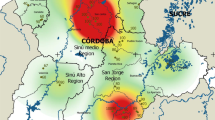Abstract
This experimental study on pigs was designed to simulate natural, long-term exposure toAscaris suum under modern management conditions. Parasite kinetics were followed in pigs receivingA. suum eggs as repeated trickle inoculations at two dose levels beginning at a body weight of 25kg until their slaughter at 90kg (baconers). In pigs inoculated twice weekly with 500 eggs, there was an initial marked rise in the numbers of hepatic milk spots, but as early as around week 6 after the start of inoculations and until week 16, at which time the last pigs were slaughtered, the numbers of spots diminished drastically. In pigs receiving only 25 eggs twice weekly, low and moderately fluctuating numbers of spots were seen throughout the experiment. Larvae recoverable from the livers and lungs were observed mainly during the beginning of the experiment. Before patency, immature intestinal worms were found in moderate numbers that showed a rough positive correlation with the dose levels, but at the time at which adult worms started to appear, immature parasites could practically no longer be found. In all, only 10 of 40 pigs harbored adults, and 4 of these 10 pigs harbored, 80% of the total worm population. The results show that acquired dosedependent host responses toA. suum play an important role in regulating the worm population along the migratory route of the parasite and that the final burden of worms in the small intestine is dose-independent and highly variable.
Similar content being viewed by others
References
Albers GAA, Gray GD (1987) Breeding for worm resistance: a perspective. Int J Parasitol 17:559–568
Anderson RM (1985) Mathematical models in the study of the epidemiology and control of ascariasis in man. In: Crompton DWT, Nesheim MC, Pawlowski ZS (eds) Ascariasis and its public health significance. Taylor & Francis, London Philadelphia, pp 39–67
Eriksen L (1981) Host parasite relations inAscaris suum infection in pigs and mice. PhD Thesis, Royal Veterinary and Agricultural University, Copenhagen
Eriksen L, Andersen S, Nielsen K, Pedersen A, Nielsen J (1980) ExperimentalAscaris suum infected pigs. Serological response, eosinophilia in peripheral blood, occurrence of white spots in the liver and worm recovery from the intestine. Nord Vet Med 32:233–242
Eriksen L, Lind P, Nansen P, Roepstorff A, Urban JF (1991) Resistance toAscaris suum in parasite naive and naturally exposed growers, finishers and sows. Vet Parasitol (in press)
Forsum E, Nesheim MC, Crompton DWT (1981) Nutritional aspects ofAscaris infection in young protein-deficient pigs. Parasitology 83:497–512
Gasbarre LC, Leighton EA, Davies CJ (1990) Genetic control of immunity to gastrointestinal nematodes of cattle. Vet Parasitol 37:257–272
Hale OM, Stewart TB, Marti OG (1985) Influence of an experimental infection ofAscaris suum on performance of pigs. J Anim Sci 60:220–225
Jørgensen RJ, Nansen P, Nielsen K, Eriksen L, Andersen S (1975) ExperimentalAscaris suum infection in the pig. Population kinetics following low and high levels of primary infection in piglets. Vei Parasitol 1:151–157
Johnson JC, Stewart TB, Hale OM (1975) Differential responses of Duroc, Hampshire, and crossbred pigs to a superimposed experimental infection with the intestinal threadwormStrongyloides ransomi. J Parasitol 61:517–524
Lind P, Eriksen L, Roepstorff A, Nansen P, Nielsen O, Urban JE (1992) Response to repeated inoculations withAscaris suum in pigs during the fattening period: II Specific IgA, IgM antibodies determined by ELISA. Parasitol Res (in press)
Luzatto L (1984) Genetic factors modifying tropical disorders. In: Warren KS, Mahmoud AAF (eds) Tropical geographical magazine. McGraw Hill, New York, pp 77–87
Muff F, Koch W, Wolff K (1984) Zur Epizootologie des Askaridenbefalles beim Schwein. Schweiz Arch Tierheilkd 126:409–428
Oksanen A, Eriksen L, Roepstorff A, Ilsøe B, Nansen P, Lind P (1990) Embryonation and infectivity ofAscaris suum. A comparison of eggs collected from worm uteri with eggs isolated from pig faeces. Acta Vet Scand 31:393–398
Roepstorff A, Eriksen L, Nansen P, Lind P, Mortensen HP, Madsen A (1989) Spolorm hos slagtesvin. Medd Statens Husdyrbrugsfors publication no. 755
Roneus O (1966) Studies on the aetilology and pathogenesis of white spots in the liver of pigs. Acta Vet Scand 7 [Suppl 16]: 1–112
Stephenson LS, Pond WG, Nesheim MC, Krook LP, Crompton DWT (1980)Ascaris suum: nutrient absorption, growth and intestinal pathology in growing pigs experimentally infected with 15-day-old larvae. Exp Parasitol 49:15–25
Urban JF Jr, Alizadeh H, Romanowski AD (1988)Ascaris suum: development of intestinal immunity to infective second-stage larvae in swine. Exp Parasitol 66:66–77
Wismer-Petersen J, Juel-Møller A, Eriksen L, Nansen P (1989) Konsistenz wärmebehandelter Schweinelebern in Abhängigkeit zum Kollagengehalt. Z Fleischwiss 3:348–350
Author information
Authors and Affiliations
Rights and permissions
About this article
Cite this article
Eriksen, L., Nansen, P., Roepstorff, A. et al. Response to repeated inoculations withAscaris suum eggs in pigs during the fattening period. Parasitol Res 78, 241–246 (1992). https://doi.org/10.1007/BF00931733
Accepted:
Issue Date:
DOI: https://doi.org/10.1007/BF00931733




